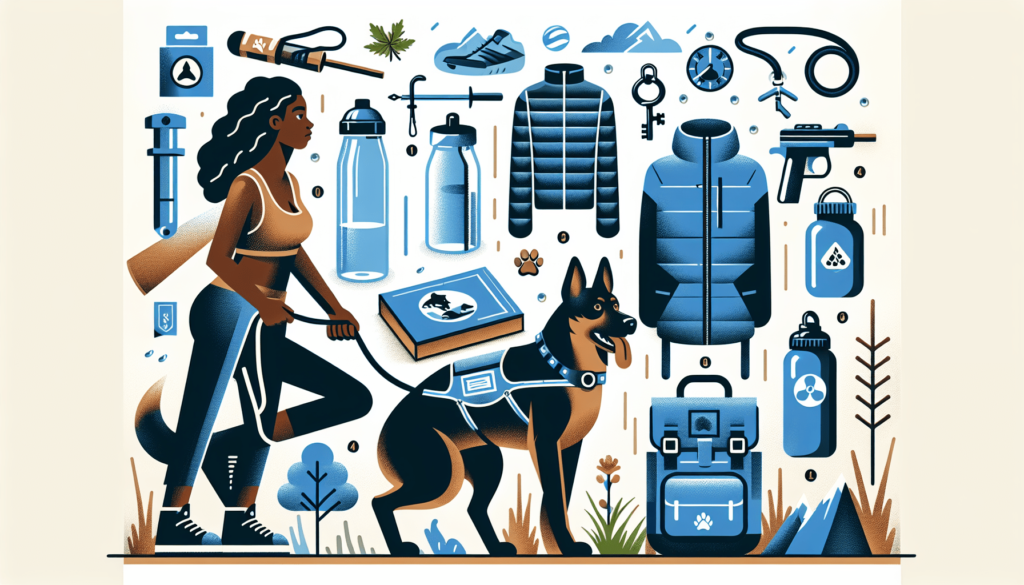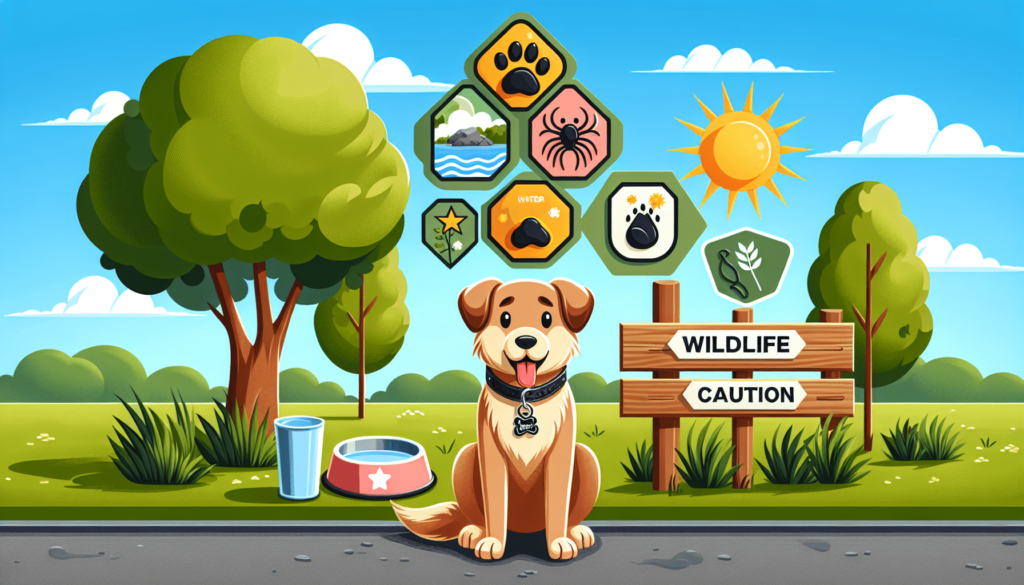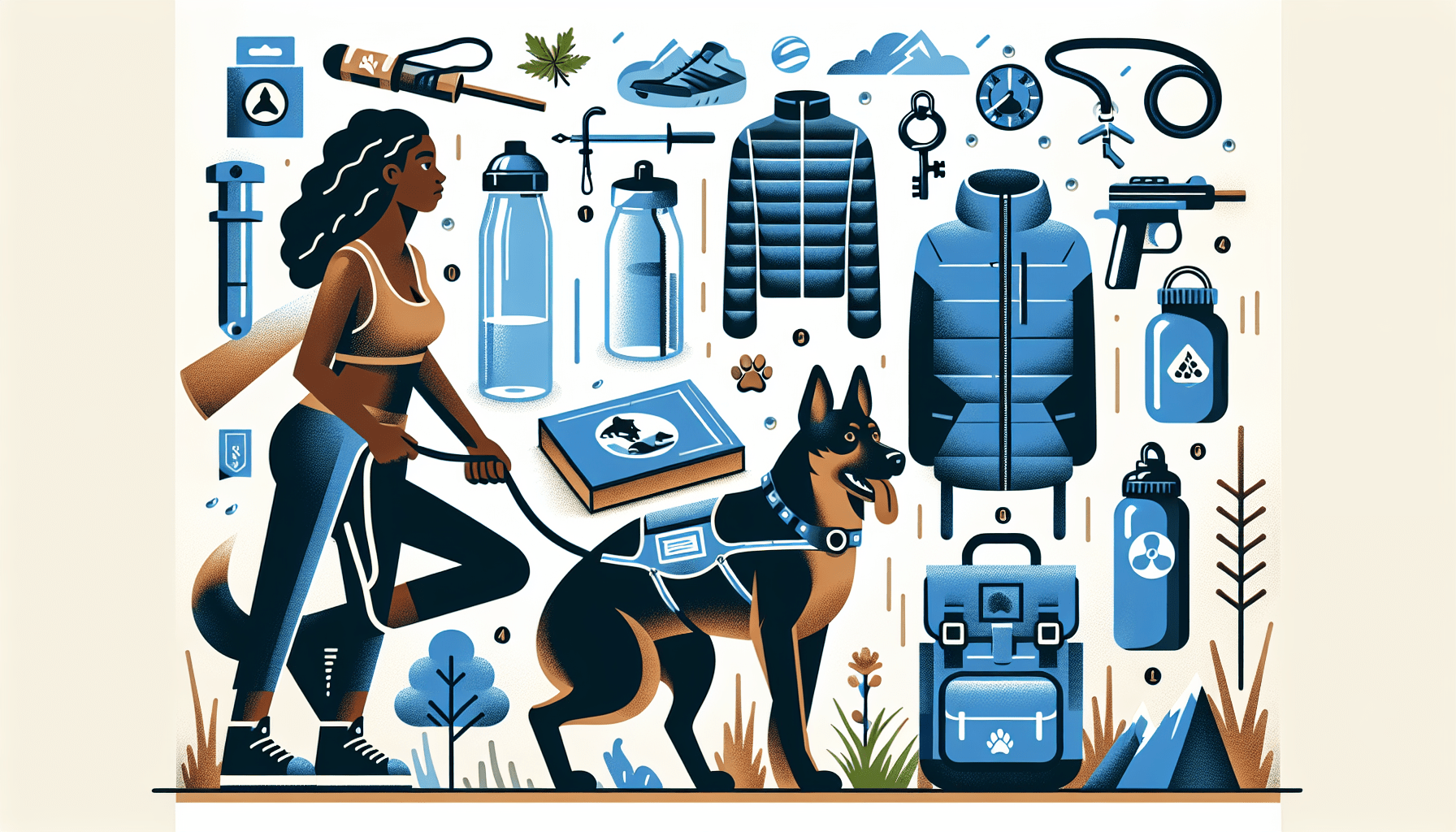Heading out for a fun day in the great outdoors with your furry best friend can be an exciting adventure. However, it is important to ensure that you are well-prepared and taking the necessary precautions to keep your dog safe. From understanding the hazards of extreme weather to keeping your pup hydrated, this article will provide you with essential outdoor safety tips for dogs. Whether you’re planning a hike, a beach day, or simply enjoying a picnic in the park, these tips will help ensure that your dog stays happy, healthy, and safe during all of your outdoor escapades.
Proper Equipment
Collar and ID tags
One of the most important pieces of equipment for your dog is a collar with ID tags. This helps to ensure that your furry friend can be easily identified and returned to you if they ever get lost. Make sure to include your dog’s name, your phone number, and any other important contact information on the ID tags.
Leash
A sturdy leash is essential for keeping your dog safe and under control during outdoor excursions. Whether you’re walking through the neighborhood or exploring the great outdoors, a leash will prevent your dog from wandering off or getting into dangerous situations. Choose a leash that’s long enough to allow your dog some freedom of movement, but short enough to maintain control.
Harness
In addition to a collar and leash, it’s a good idea to invest in a harness for your dog. Harnesses distribute the pressure evenly across your dog’s body, reducing the risk of neck strain or injury that can occur with a collar. They also give you more control over your dog’s movements, making it easier to guide them in the right direction.
Microchip
While ID tags are important, they can sometimes become lost or damaged. To provide an extra layer of protection, consider having your dog microchipped. A microchip is a small device that is implanted under your dog’s skin and contains all of their identification information. This can be invaluable if your dog ever goes missing and their collar or tags are missing.
Vaccinations and Preventive Measures
Regular vaccinations
Keeping your dog up to date on their vaccinations is essential for their health and wellbeing. Vaccines protect against common diseases and prevent the spread of illness. Make sure to schedule regular vet visits to ensure your dog receives all necessary vaccinations and boosters.
Flea and tick prevention
Fleas and ticks can cause discomfort, irritation, and even transmit diseases to your dog. To protect your furry friend, use a quality flea and tick preventative treatment. This can come in the form of a spot-on treatment, collar, or oral medication. Consult with your vet to determine the best option for your dog.
Heartworm prevention
Heartworm disease is a serious and potentially fatal condition that is spread through mosquito bites. To prevent heartworm infection, it’s important to administer monthly heartworm prevention medication to your dog. This simple preventative measure can save your dog from a painful and potentially deadly illness.

Training and Obedience
Basic commands
Training your dog in basic commands is essential for their safety and your peace of mind. Teach your dog commands such as sit, stay, down, and come. These commands will allow you to easily control your dog’s behavior in various situations, such as crossing the road or encountering other dogs.
Recall training
Recall training is crucial for ensuring your dog comes back to you when called. A solid recall can prevent your dog from running into traffic, chasing wildlife, or getting into dangerous situations. Start recall training in a controlled environment and gradually increase the distractions. Reward your dog with treats or praise for coming when called.
Socialization
Socializing your dog from a young age is important to ensure they are comfortable and well-behaved around other animals and people. Expose your dog to different environments, people, and animals to help them become confident and well-adjusted. Doggie daycare, obedience classes, and regular outings to the park can all contribute to positive socialization experiences.
Weather Considerations
Temperature extremes
Extreme temperatures can be dangerous for your dog. During hot weather, never leave your dog in a parked car, as temperatures can quickly become life-threatening. Provide shade and fresh water for your dog when outdoors in hot weather. In cold weather, provide your dog with a warm and insulated shelter, and limit their time outside in freezing temperatures.
Hot pavement
During hot summer days, pavement and sidewalks can become extremely hot and cause burns to your dog’s paws. Before taking your dog for a walk, check the temperature of the pavement with your hand or bare foot. If it’s too hot to touch, it’s too hot for your dog to walk on. Opt for grassy areas or walk your dog during cooler times of the day.
Cold weather precautions
Just like humans, dogs can suffer from hypothermia and frostbite in cold weather. If it’s too cold for you, it’s likely too cold for your dog as well. Provide your dog with a warm coat or sweater, and limit their time outside in freezing temperatures. Keep an eye out for signs of shivering or discomfort and adjust their outdoor activities accordingly.

Hydration and Nutrition
Always carry water
Keeping your dog hydrated is essential, especially during outdoor activities. Always carry a portable water bottle and a bowl for your dog. Offer water to your dog regularly, particularly during hot weather or strenuous activities. Staying properly hydrated will help keep your dog healthy and prevent heat-related illnesses.
Proper diet
Feeding your dog a balanced and nutritious diet is important for their overall health and wellbeing. Consult with your vet to determine the best diet for your dog’s specific needs. Avoid feeding your dog table scraps or foods that may be harmful to them, such as chocolate, onions, or grapes.
Avoid outdoor hazards
When outdoors, be vigilant about potential hazards that could harm your dog. Avoid leaving food or garbage accessible to your dog, as it can attract wild animals or lead to ingestion of harmful substances. Keep an eye out for sharp objects, toxic plants, or other hazards that your dog may encounter during their adventures.
Avoiding Toxic Substances
Know common pet poisons
Being aware of common pet poisons can help you protect your dog from accidental ingestion. Common pet poisons include chocolate, medications, household cleaners, and certain plants. Keep harmful substances out of your dog’s reach and be cautious when introducing new items or plants into your home.
Watch for toxic plants
Certain plants can be toxic to dogs if ingested. Research common toxic plants and ensure they are not present in your yard or in places where you walk your dog. Ingesting toxic plants can lead to various health issues, ranging from mild stomach upset to severe poisoning. If you suspect your dog has ingested a toxic plant, contact your vet immediately.
Be wary of chemicals
Chemicals found in antifreeze, pesticides, and certain household products can be poisonous to dogs. Store these substances securely and keep them out of your dog’s reach. When using chemicals outdoors, make sure your dog is kept away from treated areas until it is safe for them to be in contact with them.
Safety in Public Spaces
Leash laws
Familiarize yourself with the leash laws in your area and always adhere to them. These laws are in place for the safety and well-being of all pets and people. Keeping your dog on a leash ensures they are under control and prevents them from approaching other dogs or people without permission.
Pick up after your dog
Always clean up after your dog when they eliminate in public spaces. Not only is it considerate to others, but it also helps protect the environment and prevent the spread of diseases. Carry poop bags with you whenever you take your dog for a walk and dispose of them properly in designated waste bins.
Respect others’ space
Not all people are comfortable around dogs, so it’s important to respect their boundaries. If someone indicates that they are not comfortable with your dog approaching them or their children, respect their wishes and keep your distance. Being a responsible pet parent means being aware of others and their comfort levels.
Wildlife and Insect Safety
Avoid encounters with wildlife
While exploring the great outdoors, be mindful of wildlife that may pose a danger to your dog. Keep your dog on a leash to prevent them from chasing or approaching wild animals. Avoid areas known for having large predators or dangerous wildlife. If you encounter wildlife, slowly back away and calmly remove your dog from the situation.
Protection against ticks and fleas
Ticks and fleas can cause discomfort and transmit diseases to your dog. Use a quality tick and flea preventative treatment to protect your dog during outdoor activities. Check your dog for ticks after spending time in wooded areas or long grass and promptly remove any ticks you find.
Bee and wasp prevention
Bee and wasp stings can be painful and potentially dangerous for your dog. To prevent stings, avoid areas with high bee or wasp activity. Be cautious of your dog sniffing around flowers or other areas where bees and wasps may be present. If your dog is stung, monitor them for an allergic reaction and seek veterinary attention if necessary.
First Aid and Emergency Preparedness
Pet first aid kit
Having a pet first aid kit on hand is essential for handling minor injuries and emergencies. Your kit should include items such as bandages, antiseptic wipes, tweezers for tick removal, and any necessary medications or supplies specific to your dog’s needs. Familiarize yourself with the contents of your kit and how to use them.
Knowing basic pet CPR
Knowing the basics of pet CPR can be life-saving in emergency situations. Take the time to learn the correct techniques for performing CPR on a dog and familiarize yourself with the signs of distress or respiratory failure. In the event of an emergency, this knowledge could make a significant difference in your dog’s outcome.
Emergency contact information
Keep a list of emergency contact numbers readily available, including your veterinarian’s contact information and the nearest 24-hour animal hospital. In the event of an emergency, you’ll want to quickly reach out to professionals who can provide guidance or immediate care for your dog. Having this information easily accessible can save precious time during a crisis.
Be a Responsible Pet Parent
Regular vet check-ups
Regular veterinary check-ups are crucial for maintaining your dog’s health and catching any potential issues early on. Make sure to schedule annual or bi-annual vet visits for routine examinations, vaccinations, and preventative treatments. This proactive approach will help keep your dog happy and healthy for years to come.
Spaying/neutering
Spaying or neutering your dog not only helps control the pet population but also provides health benefits for your furry friend. These procedures can reduce the risk of certain cancers and unwanted behaviors such as aggression or roaming. Consult with your vet about the appropriate age for spaying or neutering your dog.
Obey local regulations
Familiarize yourself with and obey any local regulations or ordinances pertaining to dogs. This may include requirements for licensing, leash laws, or restrictions on certain breeds. Being a responsible pet parent means being aware of and adhering to the rules set forth by your community.
In conclusion, ensuring the safety of your beloved canine companion while enjoying the outdoors requires proper equipment, vaccinations, training, awareness of weather conditions, hydration, prevention of toxic substances and wildlife encounters, preparation for emergencies, and responsible pet parenting. By following these essential outdoor safety tips for dogs, you can provide a happy and healthy life for your furry friend while enjoying the great outdoors together.

